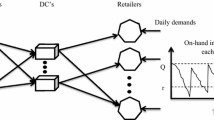Abstract
Outsourcing has been employed in supply chain management to reduce capital investment, enhance flexibility, reduce manufacturing cost, shorten cycle time, and improve service quality. This study aims to propose a portfolio optimization model considering risk diversification and delivery uncertainty for vendor portfolio selection and order allocation. Three portfolio objectives for maximizing performance of selected vendors, diversifying the portfolio risk, and minimizing total cost are considered. A comparison of two proposed stochastic programming techniques shows that robust optimization can generate a better solution whereas probabilistic models can identify the potential alternative vendor based on a data-driven approach. An application study was conducted in a leading semiconductor company in Taiwan to estimate the validity of the proposed approach. The results have shown practical viability that the proposed approach can generate the results with better vendor performance, diversified risk, and minimal total cost.







Similar content being viewed by others

References
Berger PD, Gerstenfeld A, Zeng AZ (2004) How many suppliers are best? A decision-analysis approach. Omega 32:9–15
Bhutta K (2003) Supplier selection problem: methodology literature review. J Int Technol Inf Manag 12:53–71
Bilsel RU, Ravindran A (2011) A multiobjective chance constrained programming model for supplier selection under uncertainty. Transp Res Part B 45:1284–1300
Birge JR, Louveaux F (1997) Introduction to stochastic programming. Springer, New York
De Boer L, Van der Wegen L, Telgen J (1998) Outranking methods in support of supplier selection. Eur J Purch Supply Manag 4:109–118
De Boer L, Labro E, Morlacchi P (2001) A review of methods supporting supplier selection. Eur J Purch Supply Manag 7:75–89
Chien C-F (2002) A portfolio-evaluation framework for selecting R &D projects. R &D Manag 32:359–368
Chien C-F (2005) Decision analysis and management, Yeh-Yeh Book Gallery, Taipei
Chien C-F, Sainfort F (1998) Evaluating the desirability of meals: an illustrative multiattribute decision analysis procedure to assess portfolios with interdependent items. J Multi-Criteria Decis Anal 7:230–238
Chien C-F, Chen C (2008) A novel timetabling algorithm for a furnace process for semiconductor fabrication with constrained waiting and frequency-based setups. OR Spectr 29(3):391–419
Chien C-F, Zheng J (2012) Mini-max regret strategy for robust capacity expansion decisions in semiconductor manufacturing. J Int Manu 23(6):2151–2159
Chien C-F, Kuo R (2013) Beyond make-or-buy: cross-company short-term capacity backup in semiconductor industry ecosystem. Flex Ser Manu J 25(3):310–342
Chien C-F, Wang H, Wang M (2007) A UNISON framework for analyzing alternative strategies of IC final testing for enhancing overall operational effectiveness. Int J Prod Econ 107(1):20–30
Chien C-F, Chen Y, Peng J (2010) Manufacturing intelligence for semiconductor demand forecast based on technology diffusion and product life cycle. Int J Prod Econ 128(2):496–509
Chien C-F, Wu C, Chiang Y (2012) Coordinated capacity migration and expansion planning for semiconductor manufacturing under demand uncertainties. Int J Prod Econ 135:860–869
Choi TY, Hartley JL (1996) An exploration of supplier selection practices across the supply chain. J Oper Manag 14:333–343
Chopra S, Meindl P (2012) Supply chain management: strategy, planning, and operations. 5th edn. Pearson Prentice-Hall, New Jersey
Clemen RT, Reilly T (2002) Making hard decisions with decision tools, 2nd edn. Duxbury Press, Belmont
Degraeve Z, Labro E, Roodhooft F (2000) An evaluation of vendor selection models from a total cost of ownership perspective. Eur J Oper Res 125:34–58
Dickson GW (1966) An analysis of vendor selection systems and decisions. J Purch 2:5–17
Faez F, Ghodsypour SH, O’Brien C (2009) Vendor selection and order allocation using an integrated fuzzy case-based reasoning and mathematical programming model. Int J Prod Econ 121:395–408
Fazlollahtabar H, Mahdavi I, Ashoori MT, Kaviani S, Mahdavi-Amiri N (2011) A multi-objective decision-making process of supplier selection and order allocation for multi-period scheduling in an electronic market. Int J Adv Manuf Technol 52:1039–1052
Gaonkar R, Viswanadham N (2007) Analytical framework for the management of risk in supply chains. IEEE Trans Autom Sci Eng 4(2):265–273
Ghodsypour SH, O’Brien C (1998) A decision support system for supplier selection using an integrated analytic hierarchy process and linear programming. Int J Prod Econ 56–57:199–212
Grunow M, Guenther HO, Yang G (2003) Plant coordination in pharmaceutics supply networks. OR Spectr 25:109–141
Han J, Kamber M (2001) Data mining: concepts and techniques. Morgan Kaufmann Publishers, Massachusetts
He S, Chaudhry SS, Lei Z, Baohua W (2009) Stochastic vendor selection problem: chance-constrained model and genetic algorithms. Ann Oper Res 168:169–179
Ho W, Xu X, Dey PK (2010) Multi-criteria decision making approaches for supplier evaluation and selection: a literature review. Eur J Oper Res 202:16–24
iSuppli official website (2011) http://www.isuppli.com/Manufacturing-and-Pricing/MarketWatch/Pages/Outsourced-Manufacturing-Sees-Risks-This-Year-after-Finishing-with-Strong-2010.aspx. Accessed 10 January 2012
Kara SS (2011) Supplier selection with an integrated methodology in unknown environment. Exp Sys App 38:2133–2139
Keeney RL, Raiffa H (1993) Decisions with multiple objectives: preferences and value tradeoffs. Cambridge University Press, New York
Kim DY, Wagner SM (2012) Supplier selection problem revisited from the perspective of product configuration. Int J Prod Res 50(11):2864–2876
Kull TJ, Talluri S (2008) A supply risk reduction model using integrated multicriteria decision making. IEEE Trans Eng Manag 55(3):409–419
Lee CY, Johnson AL (2013) Proactive data envelopment analysis: effective production and capacity expansion in stochastic environments. Eur J Oper Res. http://dx.doi.org/10.1016/j.ejor.2013.07.043
Lee CY, Johnson AL (2011) A decomposition of productivity change in the semiconductor manufacturing industry. Int J Prod Res 49:4761–4785
Lee CY, Johnson AL (2012) Two-dimensional efficiency decomposition to measure the demand effect in productivity analysis. Eur J Oper Res 216:584–593
Li HL, Chang CT, Tsai JF (2002) Approximately global optimization for assortment problems using piecewise linearization techniques. Eur J Oper Res 140:584–589
Li L, Zabinsky ZB (2011) Incorporating uncertainty into a supplier selection problem. Int J Prod Econ 134:344–356
Liao Z, Rittscher J (2007) A multi-objective supplier selection model under stochastic demand conditions. Int J Prod Econ 105:150–159
Liu H, Motoda H (1998) Feature selection for knowledge discovery and data mining. Kluwer Academic Publishers, Boston
Mafakheri F, Breton M, Ghoniem A (2011) Supplier selection-order allocation: a two-stage multiple criteria dynamic programming approach. Int J Prod Econ 132:52–57
Markowitz H (1952) Portfolio selection. J Finance 7:77–91
Mendoza A, Ventura JA (2012) Analytical models for supplier selection and order quantity allocation. Appl Math Model 36:3826–3835
Monczka R, Trent R, Handfield R (1998) Purchasing and supply chain management. South-Western College Publishing, Cincinnati
Mulvey JM, Vanderbei RJ, Zenios SA (1995) Robust optimization of large-scale systems. Oper Res 43:264–281
Nahmias S (2008) Production and operations analysis, 6th edn. McGraw-Hill, Irwin
Patton WW (1996) Use of human judgment models in industrial buyer’s vendor selection decisions. Ind Mark Manag 25:135–149
Petroni A, Bragia M (2000) Vendor selection using principal component analysis. J Supply Chain Manag 36:63–69
Quenouille M (1949) Approximation tests of correlation in time series. J Royal Stat Soc Ser B 11:18–84
Ravindran AR, Bilsel RU, Wadhwa V, Yang T (2010) Risk adjusted multicriteria supplier selection models with applications. Int J Prod Res 48(2):405–424
Rezaei J, Davoodi M (2011) Multi-objective models for lot-sizing with supplier selection. Int J Prod Econ 130:77–86
Ruiz-Torres AJ, Mahmoodi F (2007) The optimal number of suppliers considering the costs of individual supplier failures. Omega 35:104–115
Sarkar A, Mohapatra PKJ (2009) Determining the optimal size of supply base with the consideration of risks of supply disruptions. Int J Prod Econ 119:122–135
Sarkis J, Talluri S (2002) A model for strategic supplier selection. J Supply Chain Manag 38:18–28
Sharpe WF (1966) Mutual fund performance. J Bus 39:119–138
Sharpe WF (1971) A linear programming approximation for the general portfolio analysis. J Financial Quant Anal 6:1263–1275
Simchi-Levi D, Kaminsky P, Simchi-Levi E (2007) Designing and managing the supply chain: concepts, strategies, and cases, 3rd edn. McGraw-Hill, New York
Stadtler H (2007) A general quantity discount and supplier selection mixed integer programming model. OR Spectr 29:723–744
Stamm CL, Golhar DY (1993) JIT purchasing: attribute classification and literature review. Prod Plan Control 4:273–282
Stone B (1973) A linear programming formulation of the general portfolio selection model. J Financial Quant Anal 8:621–636
Talluri S, Narasimhan R (2004) A methodology for strategic sourcing. Eur J Oper Res 154:236–250
Tsai JF (2007) An optimization approach for supply chain management models with quantity discount policy. Eur J Oper Res 177:982–994
Tukey JW (1958) Bias and confidence in not quite large samples. Ann Math Stat 29:614
Wang HF, Kuo CY (2004) Factor analysis in data mining. Comput Math Appl 48:1765–1778
Weber CA, Current JR, Benton WC (1991) Vendor selection criteria and methods. Eur J Oper Res 50:1–17
Weber CA (1996) A data envelopment analysis approach to measuring vendor performance. Supply Chain Manag 1:28–39
Weber CA, Current J, Desai A (2000) An optimization approach to determining the number of vendors to employ. Supply Chain Manag Int J 5:90–98
Wu J, Chien C-F (2008) Modeling strategic semiconductor assembly outsourcing decisions based on empirical settings. OR Spectr 30(3):401–430
Wu DD, Zhang Y, Wu D, Olson DL (2010) Fuzzy multi-objective programming for supplier selection and risk modeling: a possibility approach. Eur J Oper Res 200:774–787
Wu J, Chien C-F, Gen M (2012) Coordinating strategic outsourcing decisions for semiconductor assembly using a bi-objective genetic algorithm. Int J Prod Res 50(1):235–260
Xu N, Nozick L (2009) Modeling supplier selection and the use of option contracts for global supply chain design. Comp Oper Res 36:2786–2800
Zeleny M (1982) Multiple criteria decision making. McGraw Hill, New York
Zhang Z, Lei J, Cao N, To K, Ng K (2004) Evolution of supplier selection criteria and methods. In: Proceedings of the second globelics conference innovation systems and Development, Emerging Opportunities and Challenges, The Hong Kong Polytech University
Zhou Y, Zhao L, Zhao X, Jiang J (2011) A supplier selection and order allocation problem with stochastic demands. Int J Sys Sci 42:1323–1338
Acknowledgments
This research was supported by the National Science Council, Taiwan (NSC99-2221-E-007-047-MY3; NSC 102-2622-E-007-013), the Ministry of Education, Taiwan (101N2073E1), and Hsinchu Science Park, Taiwan (101A53).
Author information
Authors and Affiliations
Corresponding author
Rights and permissions
About this article
Cite this article
Lee, CY., Chien, CF. Stochastic programming for vendor portfolio selection and order allocation under delivery uncertainty. OR Spectrum 36, 761–797 (2014). https://doi.org/10.1007/s00291-013-0342-7
Published:
Issue Date:
DOI: https://doi.org/10.1007/s00291-013-0342-7



